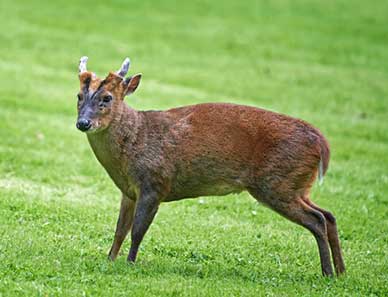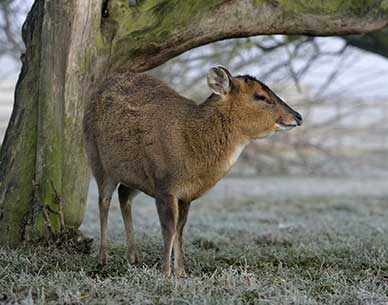Reeves Muntjac deer - identification and behaviour
How many: The Muntjac population on the Crown Lands of the New Forest is thought to be low, but is considered to have gradually increased in recent years. Muntjac deer are still, however, very rarely seen or heard.
Herds: These are often solitary animals, although newly born fawns may stay with the doe until the next birth occurs, and does are sometimes seen with bucks.
Size: Very small - up to 44 - 52 cm (17 - 20 inches) at the shoulder. Weight 9 - 18 kilos (20 - 40 lbs).
Coat: Russet brown / chestnut above in summer, grey / brown in winter. Buff / white below with a ginger tail. Moult, April - May and September - October. Fawns are born with buff spots that disappear at 8 - 12 weeks.
Rear end: No clearly discernible markings apart from a white underside to the tail.
Antlers: Males only, backward pointing single spikes 6 - 10 cm (2½ - 4 inches) long growing from lengthy pedicles. A very short brow tine is occasionally found on older bucks.
Sounds: Dog-like barking, which may be repeated at very frequent intervals for as long as 45, or more, minutes. Also makes clicking sounds when alarmed, and squeaks and screams when extremely alarmed.
Other distinguishing features: Dark coloured faces with dark brown or black stripes running up the forehead; and in males, short tusks - not always visible - projecting below the lip.
Reeves muntjac deer - unwelcome guests on the Crown Lands

(Image courtesy of Dreamstime.com)
Reeves muntjac deer are often known simply as Muntjac, and are also sometimes called Barking deer, reflecting their most frequently heard vocalisations.
They are small, though substantially built animals that typically stand as high as a large dog - in wildlife terms, they are as tall as a fox and as heavy as a badger. They usually present a 'humped back' appearance and males are typically stockier than females.
Introduced to Britain, to Woburn Park, from China in around 1894 - there seems to be an element of doubt about the exact date - some were released from the park as early as 1901 but they are not thought to have become established in the wild until the 1920s and were still considered to be only locally distributed into the 1940s and 1950s.
Subsequent spread was aided by further releases in a variety of locations, with individuals being first noted in areas bordering the Crown Lands of the New Forest in the late 1960s. Presence on the Crown Lands was not, though, universally accepted until at least the late 1980s.
(Reeves muntjac are also sometimes referred to as Chinese muntjac so as to differentiate them from the closely related, but larger, Indian muntjac, which was also introduced to Woburn, in their case in around 1900. At least five other Muntjac species are known in southern Asia, although only Chinese and Indian muntjac have been brought to Britain. The Indian muntjac, however, is now not found in the wild in the UK).
Establishing presence in their favoured woodland habitats can be something of a challenge for these deer are often incredibly inconspicuous creatures with a liking for thick cover. They frequently reveal themselves only by intermittent dog-like yapping - yet even when clearly heard, the barking might not immediately register with passers-by as Muntjac barking, so dog-like is the sound.
(Contrarily, the first one that I knowingly encountered, in the 1990s, was trotting down Beechen Lane, on the edge of Pondhead Inclosure, near Lyndhurst, in the middle of the day.
Then as an example at the other end of the spectrum, in late 2016, whilst standing quite still, photographing fallow deer in Brinken Wood, I gradually became aware of a repetitive, yapping bark coming from nearby undergrowth, a sound which initially I had not really noticed such was the level of concentration directed towards the fallow deer. The bark continued intermittently for at least another 30 minutes and, as neither dog nor dog walker appeared, I can only assume that the barker was a muntjac deer).

(Image courtesy of Dreamstime.com)
Field signs may betray the whereabouts of these deer, but differentiating the signs from those left by roe deer is not easily achieved - Muntjac droppings are small and black; slots are small and delicate; saplings are sometimes frayed although significant damage to timber is considered unusual; and well-worn courtship rings may be formed on the ground.
Unlike our other deer species, Muntjac do not have a fixed breeding season and can produce two litters - of one youngster - in a calendar year with births at seven month intervals. Antlers, however, are consistently shed between May and July.
The presence of Muntjac deer is not thought to significantly adversely affect other deer species, although outside the New Forest, there is apparently some evidence that roe deer numbers have fallen following the arrival of Muntjac - presumably as a result of competition for foodstuffs.
But Muntjac, particularly when present at high densities, can frequently devour woodland plants at what has been described as a 'terrifying rate' and can therefore significantly adversely affect the vegetation, including hazel coppice re-growth - as in Pondhead Inclosure - and butterfly and other insect food plants, and damage vital bird nesting, feeding and sheltering sites.
Consequently, at least in part, Forestry Commission policy is to prevent a Muntjac population from becoming established in the New Forest with every effort being made to shoot any known to be present apart from, on welfare grounds, females believed to have dependent young.
In reality, however, eradicating these deer completely from the Crown Lands is virtually impossible, and even if it were to be achieved, others would probably move in from the surrounding countryside.
(As an introduced, non-native species, Muntjac deer may not now be legally released into the wild under the provisions of the Wildlife and Countryside Act 1981).
New Forest deer - find out lots more
References:
The History of British Mammals: Derek Yalden
Deer Watch: Richard Prior
New Forest Roe deer: John K. Fawcett
Roe deer: John K. Fawcett
Sika deer: Rory Putman
Fallow deer: Jochen Langbein and Norma Chapman
More links
Other related links
Search this site

Sadly, 58 animals were killed - 35 ponies, 13 cows, 8 donkeys and 2 sheep, whilst a further 32 were injured - 3 pigs, 9 donkeys, 11 cows and 9 ponies.
(Forty-three accidents occurred in daylight, 15 at twilight and 101 in the dark. Twenty-seven accidents were not reported by the driver involved).
Here's just one horrific example - Three donkeys killed in collision with van at notorious New Forest blackspot (Advertiser and Times)

